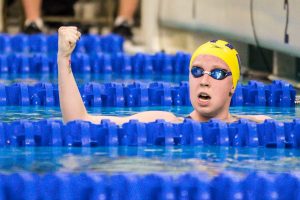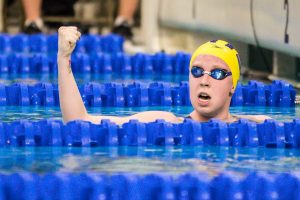By Sierra Schmidt, U-M Women’s Swim & Dive alumna, with foreword by Emily Klueh, LMSW
It is well known and researched that the practice of mindfulness and meditation can have impacts on physical, mental, and emotional well-being and health. For athletes, we know that mindfulness can help slow down the system, differentiate between helpful vs. unhelpful thinking styles, and improve performance. A specific practice that combines mindfulness, meditation, and intentional relaxation is Restorative Yoga. Restorative Yoga helps to reduce tension, slow the mind, and bring an intentional calm to the body, something that is hard to come by for athletes, especially student-athletes who are balancing academic workload and the rigors of performance. At the University of Michigan, we are fortunate enough to support a variety of mindfulness and meditation practices and services. One such opportunity is provided by our Restorative Yoga certified clinicians. Restorative yoga is different from other types of yoga as it is focused on deliberate stillness. The sessions last roughly one hour and an individual will only move a handful of times into positions specifically created to release tension, enhance recovery, and slow the mind. Student-athletes find significant benefits attending these sessions. In fact, nearly all (94%) Michigan student-athletes who participated in Restorative Yoga in 2018-2019 reported experiencing at least one important benefit, with less stress, more happiness or better mood, and better sleep being the most commonly reported benefits.
Former U-M swimmer and six-time NCAA All-American Sierra Schmidt shares her experience engaging in restorative yoga:
I heard about restorative yoga from my therapist at the Sports Psychology office in Weidenbach Hall. At first I was very skeptical. How much of a difference could an hour of sitting in a dark room and being quiet do for a swimmer who is constantly moving from place to place all day long? But my therapist insisted that it was. Walking into my first session of restorative yoga was scary, to say the least. As someone who had never meditated in her whole life, and was used to moving, talking or just generally vibrating at all times, an hour sitting still and just existing was intimidating. The word yoga also gave me a sense of dread – did I want to do more exercise than I already did? At this point in my mental health journey, being alone with my thoughts was a terrifying concept, so, I challenged myself to go to a session of restorative yoga. I thought, “What could go wrong? You need to get out and try new things and not just hide in your apartment all the time!” So, I arrived at the South Performance Center with a lot of questions and a lot of dread.
There were a few things I found out: first, some of my teammates were also trying it out. That gave me a lot of comfort seeing that I wasn’t just going to be alone with the leader or with people I didn’t know. Second, that it was not as scary as it sounded. Lastly, that I had found my new favorite pastime. All of the thoughts that were playing ping pong inside my head were suddenly resting for the moment. I could deconstruct my anxieties one by one, instead of facing the army that I usually had to challenge. The positions we had to go into were simple and comfortable positions. As someone who has seen ads for yoga before and seen the pretzel-like positions, you could say I was more than a bit surprised.
“I realized that it was the most relaxed I had felt in a long time.”
For the hour session, there were only four positions. The positions were easy to get into and the focus was on mental relaxation, not pushing your body. When thinking of yoga, I think of the really complex positions that test your balance and flexibility. But I found that it was much simpler as the positions were comfortable! Before I knew it, I was so relaxed that I fell asleep. Once I heard the instructor walk up to me to wake me up, I realized that it was the most relaxed I had felt in a long time. The next morning, I didn’t need coffee to wake me up fully and I was more engaged with my team. Practice didn’t seem as daunting as it usually did. I noticed a huge change in my attitude and mental health, so I made a point to sign up for every session that I could.
As I went home for a short time and reflected on my restorative yoga journey, I decided to explore more forms of meditation. I found more services to explore in my free time, and really got into the art of meditating and relaxing. I have found that some meditation programs are more intensive and try to engage me too much, whereas Restorative Yoga gave me a chance to unwind and relax so I could maximize my sleep. It also gave me a chance to reflect on the things that happened during my day, both good and bad. Since then I have felt more gratitude about my life. When things do go wrong, I have a space where I can take a deep breath and detangle my thoughts and feelings.
As mentioned above by Sierra, athletes often are in a constant state of thinking, questioning, rushing, and doing. The athletics culture is often focused on ways to improve by striving to do more, not less. Thus, having a space to let go of stressors or organize thoughts without having more worries thrown in the mix is extremely important. It has been valuable for our athletes to experiment with and understand the benefits of creating a time and place to mentally unwind, build resilience, and promote recovery. We will continue to provide and push for new opportunities that help our student-athletes find a balance, experience growth, and build skills to navigate the intensity of being a student-athlete during their time here at U-M.
________________________________________________________________________________________________________________________________________
About the Author
Sierra is a recent alum (’21) of the University of Michigan, and spent her four years at Michigan as a part of the Swimming and Diving Team. She is a six-time All American, a Big Ten Champion, and was a Captain of the 2020-2021 Team.
Schmidt is now involved in initiatives with USA Swimming and the United States Olympic and Paralympic Committee to promote the excellence of collegiate athletes from around the U.S. She is currently residing in Phoenix, AZ where she is continuing her journey as a professional swimmer, while also pursuing her love of filmmaking.



